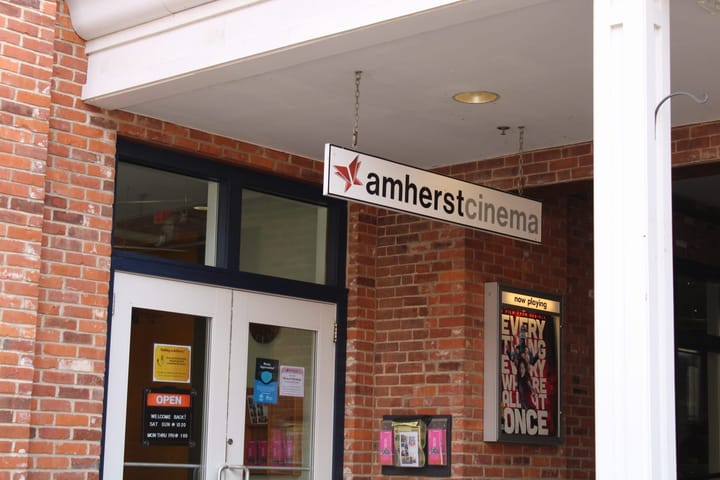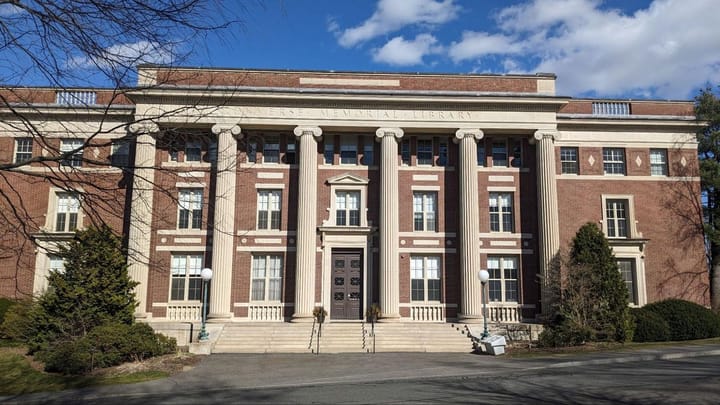College History Discussed in Facebook Livestream
In a Facebook livestream titled “Amherst History Live,” Senior Writer for the Office of Communications Katharine Whittemore hosted President Biddy Martin, Dean of the Faculty Catherine Epstein and Head of Archives and Special Collections Michael Kelly for a discussion on the history of Amherst College. The discussion, which took place on Nov. 13, covered the institution’s origins, notable figures, athletics and fun facts.
Whittemore started off by asking Martin what resonated with her the most about the college’s origin story and why she discussed the history of the college at Convocation this year. Martin said she was inspired by Epstein’s address at last year’s Senior Assembly, where Epstein discussed a book by the college’s 11th president, Stanley King, who served from 1932 to 1946.
“I’ve been thinking for a while that our students don’t get enough information from us about the history of the college and their place in it. So I decided to talk about the college and its early days and the portraits in [Johnson] Chapel,” Martin said. “It occured to me that [ first years] will already have been in the chapel for several events, but no one had probably said anything to them about who these people are in the portraits in the chapel.”
She added that what intrigued and inspired her the most about the college’s origins was its founders’ passion for education, specifically in their efforts of fundraising to send young men to college — what Martin referenced as the beginnings of financial aid at Amherst.
The discussion then moved to previous college presidents. Epstein said that she admired Alexander Meiklejohn, the college’s eighth president.
“He really put Amherst on the intellectual map. He put a lot of effort into getting top-rate professors who were stellar teachers,” Epstein said. “Meiklejohn helped Amherst make the transition from a kind of … not exactly mediocre institution, [but one] that didn’t really focus on intellectual rigor and intellectual excellence. He really made that the center of Amherst. I think we owe a lot to Meiklejohn along those lines.” Kelly also noted that Meiklejohn was responsible for bringing acclaimed poet Robert Frost to teach at Amherst.
Epstein and Kelly credited the college’s third president, Edward Hitchcock, for bringing the natural sciences to Amherst. Kelly described how the Octagon, the school’s first natural history museum and observatory, was commissioned by Hitchcock.
Kelly said that he was personally intrigued by William Stearns, the college’s fourth president, and how he faced the difficult task of preventing students from participating in the Civil War. Kelly said that if Stearns had not actively tried to dissuade students and faculty from joining the war, the school may have collapsed due to a lack of tuition revenue.
During the livestream, a musket stamped with “Amherst College Gymnasium” was on display. This musket, which was recently purchased by Archives & Special Collections, was part of the program employed by Stearns to prevent students from joining the Civil War. In 1861, Stearns convinced the Board of Trustees to lift the college’s firearm ban and authorized musket drills as part of athletic activities.
The sounds of musket drills were part of the Amherst soundscape during the Civil War, said Martin and Kelly, and affected nearby poet Emily Dickinson. The sounds of musket drills and the death of Frasier Stearns — son of President Stearns and a friend of Dickinson — at the Battle of Newbern in 1862 were described in Dickinson’s poetry and letters, said Kelly.
The discussion then moved towards the ongoing development of the Amherst curriculum.
“Amherst tends to go to the extremes,” Epstein said about the history of the college’s academic curriculum. “I believe in 1828 a professor proposed a curriculum based on modern languages. It didn’t last very long, but it was very radical at the time.”
Amherst adopted an elective-based curriculum at the end of the 19th century, Epstein said, which was very unusual at the time, and implemented a core curriculum during the 1946-1947 academic year. Epstein said the core curriculum was popular among alumni, though Amherst switched to the open curriculum in the late 1960s. All of the college catalogs from 1821 up until 2013 are on the college’s digital collections website, Kelly added.
When the topic of Amherst athletics was raised, Kelly noted that Amherst held the first intercollegiate baseball game in 1859 against Williams. Kelly also mentioned former captain of the Amherst football team William Henry Lewis, who became captain of the team in 1892 and later went on to play football at Harvard Law School. Appointed by President Howard Taft in 1910, he later became the first black assistant attorney general.
The livestream concluded with a discussion on the alleged portion of books taken from the Williams’ library by Amherst’s founder Zephaniah Swift Moore.
Kelly stated that at that time, books used in classes often belonged to the instructor, so the books brought by Moore were most likely his personal books. Martin added that Williams declared the account to be false in 2013.
The archives have recently mapped and organized the original books and archives brought to the college at its inception in 1821, which can be found on the digital collections website, Kelly said.





Comments ()